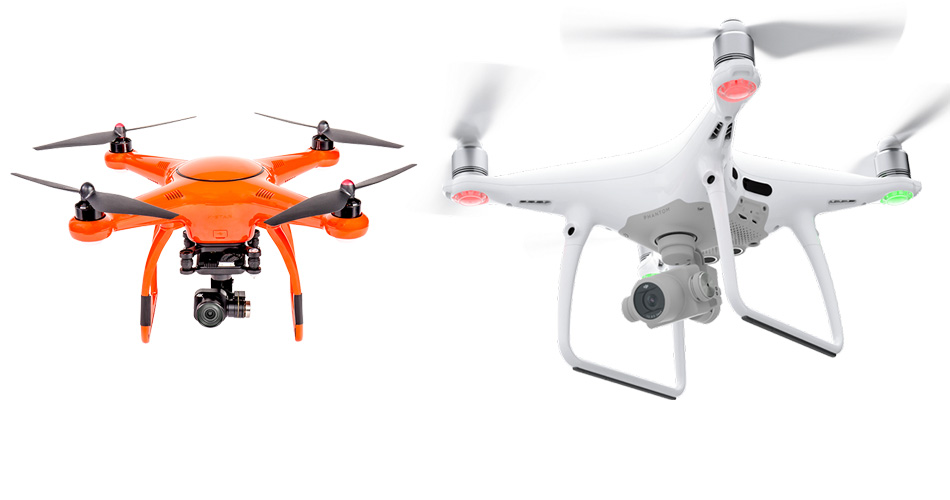Autel vs DJI
Autel and DJI are two big-name drone manufacturers who are currently battling it out. But which has the best machines? Well, we will be comparing DJI’s Phantom range, Inspire 2, Mavic Pro, and Spark, against Autel’s X-star drones. These are each companies’ major drone models, and all are still currently being produced. An overall winner will be determined, as well as the best value for money.
Photos And Video
A major reason to get a drone is for taking amazing aerial footage. For those that inspire to do so, you will need a decent camera. Check out the specs below.
| Model | Megapixels | Frames per Second |
|---|---|---|
| DJI Phantom 3 Pro | 12 | 30fps (4K) |
| DJI Phantom 4 Advanced | 20 | 60fps (4K) |
| DJI Phantom 4 Pro | 20 | 60fps (4K) |
| DJI Inspire 2 | 20 | 60fps (4K), 30fps (5.2K) |
| DJI Spark | 12 | 30fps (1080p) |
| DJI Mavic Pro | 12 | 30fps (4K) |
| Autel X-star | 12 | 30fps (4K) |
| Autel X-star Premium | 12 | 30fps (4K) |
As you can see the Phantom 4 Advanced, Phantom 4 Pro, and Inspire 2 are the clear winners. They really put the Autel drones to shame, with a higher megapixel and frame rate. This means they can take crisper and more high-definition photos and videos.
+1 for the Inspire 2.
+1 for the Phantom 4 Advanced.
+1 for the Phantom 4 Pro.
Flight Speed And Time
Check the flight capabilities for each drone below. Just remember these are maximum figures. Wind conditions, the drone’s operational mode, and other factors can affect them.
| Model | Max Speed (mph) | Max Flight Time (minutes) |
|---|---|---|
| DJI Phantom 3 Pro | 38.5 | 23 |
| DJI Phantom 4 Advanced | 45 | 30 |
| DJI Phantom 4 Pro | 45 | 30 |
| DJI Inspire 2 | 58 | 27 |
| DJI Spark | 31 | 16 |
| DJI Mavic Pro | 40 | 27 |
| Autel X-star | 35 | 25 |
| Autel X-star Premium | 35 | 25 |
The Inspire 2 leaves all other models in the dust with a staggering 58mph max speed. Enough said.
Now, every minute can seem like an hour when fully engaged in flying your drone. That’s why flight time is very important. The Phantom 4 Advanced and Phantom 4 Pro are the clear winners with the ability to stay airborne for 30 minutes. They are closely followed by the Inspire 2 and Mavic Pro with 27 minutes, and then the X-star drones lagging behind a bit with 25 minutes.
+1 for the Inspire 2.
+1 for the Phantom 4 Advanced.
+1 for the Phantom 4 Pro.
Range
The max range is the total distance a drone can fly away from its controller before losing the signal. Just remember, interference levels and the nature of the landscape (hills etc.) can affect signal coverage. The closer a drone gets to its maximum range the higher likelihood of connection dropouts.
Also be aware that it is illegal in many locations to fly a drone beyond your field of vision.
| Model | Max Range (miles) |
|---|---|
| DJI Phantom 3 Pro | 3.1 |
| DJI Phantom 4 Advanced | 4.3 |
| DJI Phantom 4 Pro | 4.3 |
| DJI Inspire 2 | 4.3 |
| DJI Spark | 1.2 |
| DJI Mavic Pro | 4.3 |
| Autel X-star | 0.6 |
| Autel X-star Premium | 1.2 |
You will now notice the main difference between the X-star and X-star Premium. Everything about them is pretty similar except for the control range. The X-star Premium has double that of the X-star.
The overall winners are the Phantom 4 Advanced and Pro, the Inspire 2, and the Mavic Pro with 4.3-mile ranges. This is due to their incorporation of DJI’s Lightbridge Technology, which allows for a much greater range than a wifi connection.
+1 for the Inspire 2.
+1 for the Mavic Pro.
+1 for the Phantom 4 Advanced.
+1 for the Phantom 4 Pro.
Controller Design
Autel’s X-star drones controllers look very similar to those of DJI’s Phantom range and Inspire 2. Put them side by side, and you will not notice a lot of difference. Each has similar dimensions, two control sticks, an array of buttons, and a mount for attaching a smartphone or tablet.
The Spark and Mavic Pro controllers have similar features but are more compact. This makes them more portable, and some users will find them more ergonomic. The Mavic Pro controller also has a built-in flight data screen.
Overall we reckon the Mavic Pro has the best controller. It is small, easy to use, has a data screen, and of course, you can mount your smartphone or tablet to it.
+1 for the Mavic Pro.
Obstacle Avoidance
The Phantom 4 range, Inspire 2, Spark, and Mavic Pro all have dedicated obstacle avoidance systems. These detect obstacles ahead and downwards, to automatically prevent an accidental collision. The Inspire 2 can also detect obstacle above it, while the Phantom 4 Pro has sensors on its sides and rear, which allow for 360 degrees of obstacle detection.
Unfortunately, the Phantom 3 Pro and X-star drones lack obstacle avoidance systems.
+1 for the Phantom 4 Advanced.
+1 for the Phantom 4 Pro.
+1 for the Inspire 2.
+1 for the Spark.
+1 for the Mavic Pro.
Positioning Systems
Each drone uses GPS and GLONASS positioning for maximum accuracy. They also use vision positioning modules. These are downwards facing sensors that help each drone determine it position when low to the ground. This allows them to fly effectively at low altitudes and maintain hover accuracy without wobbling around too much.
There is no overall winner in this category.
Intelligent Flight Modes
Each drone comes with a variety of intelligent flight modes allowing for much greater control. Some of the modes that are consistent with all models are described below.
- Follow me- Pretty self-explanatory. This mode causes the drone to follow its operator.
- Waypoints – This allows users to place waypoints using the DJI or Starlink(Autel) App. This causes the drone to automatically follow the path set by the waypoints.
- Orbit/Circle- Causes the drone to continuously fly around an object, person, or landscape feature.
- Beginner- Limits flight speeds so that new users can practice
These are just a few examples. We could literally write another whole article describing all the modes for every drone. However, we will leave it at that. As every user is different and will want to fly their drone in different ways, its hard to know exactly what modes are most suitable, which makes it difficult to select an overall winner in this category.
Price Comparison
Check out the approximate Amazon prices for each drone below.
| Model | Approximate Price | Check Current Price |
|---|---|---|
| DJI Phantom 3 Pro | $800 | |
| DJI Phantom 4 Advanced | $1,150 | |
| DJI Phantom 4 Pro | $1,400 | |
| DJI Inspire 2 | $2,900 | |
| DJI Spark | $550 | |
| DJI Mavic Pro | $900 | |
| X-star | $700 | |
| X-star Premium | $900 |
As you can see the cheapest drone is the Spark at $550 while the Inspire 2 hits the other end of the scale at a massive $2,900.
+1 for the Spark.
Let’s See The Scores
| Model | Total Score |
|---|---|
| DJI Phantom 3 Pro | 0 |
| DJI Phantom 4 Advanced | 4 (Camera, flight time, range, obstacle avoidance) |
| DJI Phantom 4 Pro | 4 (Camera, flight time, range, obstacle avoidance) |
| DJI Inspire 2 | 4 (Camera, max speed, range, obstacle avoidance) |
| DJI Spark | 2 (Price, obstacle avoidance) |
| DJI Mavic Pro | 3 (Range, obstacle avoidance, controller) |
| Autel X-star | 0 |
| Autel X-star Premium | 0 |
To be fair, the results are looking a bit one-sided when it comes to DJI vs Autel. The X-star drones don’t cut it in comparison to DJI’s latest models.
Best Overall Choice
Let’s analyze these results. First off, the Phantom 4 Advanced and Pro have the same score. However, the Pro model has side and rear obstacle sensors, making it a more capable machine. So really the showdown is between the Phantom 4 Pro and Inspire 2. They are similar in a lot of ways but also have some key differences.
The first difference is that the Phantom 4 Pro has the longer flight time while the Inspire 2 has the higher max speed. Next, the Inspire 2’s camera is a bit better than the Phantom 4 Pro’s because it can shoot 5.2K video. Lastly, the Phantom 4 Pro has slightly better obstacle avoidance.
We reckon the differences in flight time and max speed are an even trade-off, so the big question you have to ask is do you want to pay another $1,500 for the Inspire 2’s better camera. Serious filmmakers may want to, but we reckon the typical person is better off getting the cheaper Phantom 4 Pro.
Best Value For Money
The Mavic Pro is the best value for money. It is around $500 cheaper than the Phantom 4 Pro and $2,000 cheaper than the Inspire 2. For this lower cost, you are still getting a good all-round drone, which comes with obstacle avoidance, a 4.3-mile flight range, and an awesome controller.
Overall Top Manufacturer
It’s pretty obvious that we think DJI is the much greater drone manufacturer. Not only does it have the widest variety of drones but they are also more high-tech. In fact, the X-star models are rather dated when it comes to their cameras, lack of obstacle avoidance, and short control range.



lol dji is trash they’re more expensive because they’re well known. Autel is growing in competition. and speaking with UAV advisors they clearly state that the X-Star Premium has far better capabilities then several of the DJI models, For Example: a interchangeable gimble and camera that can be switched for several different cameras such as thermal cameras (one point for X-Star Premium). The X-Star Premium also has a 3D mapping capability where the drone can scan an object (building) and can give a detailed 3 dimensional layout. (another point for the Autel X-Star Premium) The X-Star also includes interchangeable lenses which can better fit your shot. (one more point for Autel) Besides the obvious facts that the X-star is superior, this drone is much cheaper and worth much more. The X-star Premium sells for $699, and includes 3 batteries, And a hard carrying case. Which dji does not provide. At least in the phantom 3. This page has been reviewed by my colleagues and I strongly beleive that this article is obviously biased.